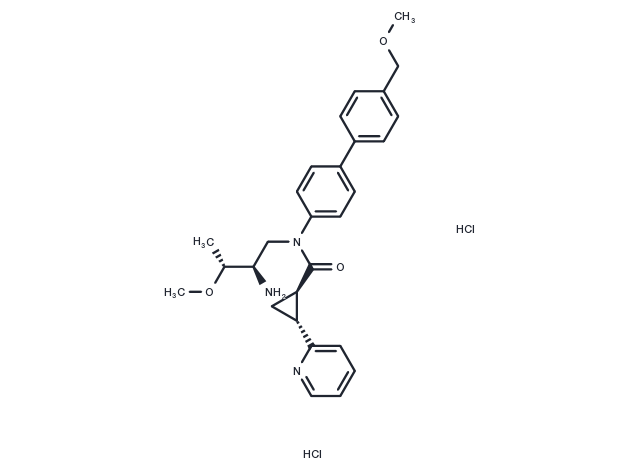Powder: -20°C for 3 years | In solvent: -80°C for 1 year


RTI-13951-33 hydrochloride is a potent, selective, and brain-penetrant GPR88 agonist. RTI-13951-33 hydrochloride exhibited an EC 50 of 25 nM in vitro cAMP functional assay. RTI-13951-33 hydrochloride significantly reduces alcohol reinforcement and intake behaviors in rats [1].

| Pack Size | Availability | Price/USD | Quantity |
|---|---|---|---|
| 25 mg | 10-14 weeks | $ 1,360.00 | |
| 50 mg | 10-14 weeks | $ 2,280.00 |
| Description | RTI-13951-33 hydrochloride is a potent, selective, and brain-penetrant GPR88 agonist. RTI-13951-33 hydrochloride exhibited an EC 50 of 25 nM in vitro cAMP functional assay. RTI-13951-33 hydrochloride significantly reduces alcohol reinforcement and intake behaviors in rats [1]. |
| Targets&IC50 | GPR88:(EC50)25 nM |
| In vitro | RTI-13951-33 is a potent and selective GPR88 agonist that effectively crosses the blood-brain barrier, demonstrating a significant effect with an EC50 value of 25 nM in GPR88 cAMP functional assays. It also increases [35S]-GTPγS binding in the mouse striatum with an EC50 of 535 nM, a response absent in GPR88 knockout (KO) mice. Despite its primary activity, RTI-13951-33 exhibits weak affinities for the kappa opioid receptor (KOR; Ki, 2.29 μM), the vesicular monoamine transporter (VMAT; Ki, 4.23 μM), and a moderate affinity for the serotonin transporter (SERT; Ki, 0.75 μM). However, it demonstrates poor inhibition of SERT, with an IC50 of 25.1±2.7 μM. |
| In vivo | RTI-13951-33 (10 and 20 mg/kg, i.p.) decreases alcohol lever responses in a rat model of alcohol self-administration in a dose-dependent manner [1]. RTI-13951-33 (10 mg/kg, i.p.) shows sufficient brain penetration, with t 1/2 of 48 min and 87 min in rat plasma and brain [1]. |
| Synonyms | RTI-13951-33 hydrochloride (2244884-08-8 free base) |
| Molecular Weight | 532.5 |
| Formula | C28H35Cl2N3O3 |
| CAS No. | T12778 |
Powder: -20°C for 3 years | In solvent: -80°C for 1 year
DMSO: 125 mg/mL (234.74 mM), Sonication is recommended.
You can also refer to dose conversion for different animals. More
bottom
Please see Inhibitor Handling Instructions for more frequently ask questions. Topics include: how to prepare stock solutions, how to store products, and cautions on cell-based assays & animal experiments, etc.
RTI-13951-33 hydrochloride T12778 Others 2244884-08-8 free base RTI-13951-33 hydrochloride (2244884-08-8 free base) RTI 13951 33 hydrochloride 2244884-08-8 RTI1395133 hydrochloride RTI-13951-33 Hydrochloride inhibitor inhibit
